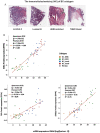Prevalence of Breast Cancer Subtypes Among Different Ethnicities and Bangladeshi Women: Demographic, Clinicopathological, and Integrated Cancer Informatics Analysis
- PMID: 36684416
- PMCID: PMC9850134
- DOI: 10.1177/11769351221148584
Prevalence of Breast Cancer Subtypes Among Different Ethnicities and Bangladeshi Women: Demographic, Clinicopathological, and Integrated Cancer Informatics Analysis
Abstract
Background: The molecular subtyping of breast cancer is related to estrogen receptor (ER), progesterone receptor (PR), and human epidermal growth factor receptor 2 (HER2). The present study aimed to systematically analyze the expression, function, and prognostic value of ER, PR, HER2, and their prevalence in different ethnic groups and among Bangladeshi breast cancer (BC) patients.
Method: This study included 25 BC patients and 25 healthy controls, aged between 25 and 70 years. The study characteristics were compared using the ANOVA and Chi-square tests. Also, the multi-Omics dataset of 775 BC patients from TCGA was analyzed for ER, PR, and HER2 in breast cancer subtypes and compared among different ethnicities.
Results: For most BD breast cancer cases, the age at diagnosis was ⩾40 years, had only a histopathological diagnosis (P-value .004), and no history of mammography or other pathological tests. For treatment, had only chemotherapy (P-value .004) and no hormone therapy (P-value <.001). The majority of patients (>60%) were of stage-II cancer and TNBC (40%) subtype. The BC ethnicity-stratified data of ER, PR, and HER2 indicated a strong correlation across all ethnicities (P-value 4.99e-35; P-value 3.79e-18). The subtypes stratified data indicated a higher percentage of Luminal A (58.3%) in Caucasians whereas Luminal B (24.3%) and HER2 (25.2%) subtypes were found higher in Asians and TNBC (36.0%) were found in Africans. However, a significantly higher frequency of TNBC (52.2%) compared to Asians (14.8%) was found in BD patients (P-value <.001). The overall survival analysis of BC subtypes demonstrated that Luminal B (P-value .005) and HER2 enriched (P-value .015) were significantly more aggressive and were dominant in the Asian population.
Conclusion: A significant association was found between BC subtypes with different ethnicities and Bangladeshi women and these findings might aid in the prevention, management, and raising of awareness against risk factors in the near future.
Keywords: Breast cancer; TCGA; cBioPortal; estrogen receptor (ER); human epidermal growth factor receptor 2 (HER2); luminal A; luminal B; progesterone receptor (PR); subtypes; survival analysis; triple-negative breast cancer (TNBC).
© The Author(s) 2023.
Conflict of interest statement
The author(s) declared no potential conflicts of interest with respect to the research, authorship, and/or publication of this article.
Figures






References
-
- World Health Organization (WHO). Global cancer observatory, cancer today, graph: pie chart of estimated incidences in 2020 for cancer sites. Accessed 19 July 2022, Available at: https://gco.iarc.fr/today/online-analysis-pie
-
- World Health Organization (WHO). Fact sheets, details about breast cancer. Accessed 21 July 2022, Available at: https://www.who.int/news-room/fact-sheets/detail/breast-cancer
-
- World Health Organization (WHO). Global cancer observatory, cancer today, table: estimated number of cases in 2020 worldwide. Accessed 2o July 2022, Available at: https://gco.iarc.fr/today/online-analysis-table?
-
- World Health Organization (WHO). Global cancer observatory, cancer today, graph: estimated number of cases in 2020. Accessed 21 July 2022, Available at: https://gco.iarc.fr/today/online-analysis-multi-bars?
-
- WHO.int. Breast cancer. 2021. Accessed 22 July 2022, Available at: https://www.who.int/news-room/fact-sheets/detail/breast-cancer
LinkOut - more resources
Full Text Sources
Research Materials
Miscellaneous

